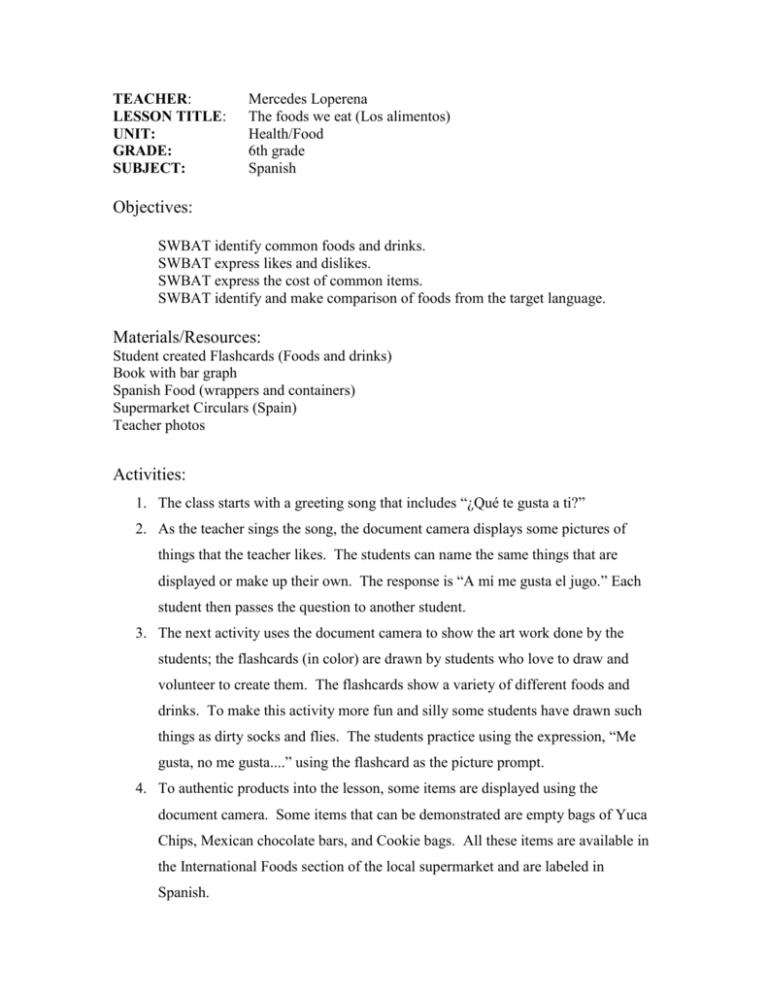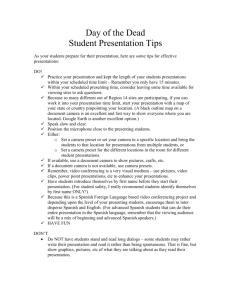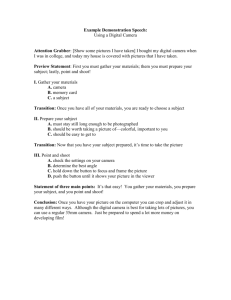Grades 6: Learning Spanish With Food
advertisement

TEACHER: LESSON TITLE: UNIT: GRADE: SUBJECT: Mercedes Loperena The foods we eat (Los alimentos) Health/Food 6th grade Spanish Objectives: SWBAT identify common foods and drinks. SWBAT express likes and dislikes. SWBAT express the cost of common items. SWBAT identify and make comparison of foods from the target language. Materials/Resources: Student created Flashcards (Foods and drinks) Book with bar graph Spanish Food (wrappers and containers) Supermarket Circulars (Spain) Teacher photos Activities: 1. The class starts with a greeting song that includes “¿Qué te gusta a ti?” 2. As the teacher sings the song, the document camera displays some pictures of things that the teacher likes. The students can name the same things that are displayed or make up their own. The response is “A mí me gusta el jugo.” Each student then passes the question to another student. 3. The next activity uses the document camera to show the art work done by the students; the flashcards (in color) are drawn by students who love to draw and volunteer to create them. The flashcards show a variety of different foods and drinks. To make this activity more fun and silly some students have drawn such things as dirty socks and flies. The students practice using the expression, “Me gusta, no me gusta....” using the flashcard as the picture prompt. 4. To authentic products into the lesson, some items are displayed using the document camera. Some items that can be demonstrated are empty bags of Yuca Chips, Mexican chocolate bars, and Cookie bags. All these items are available in the International Foods section of the local supermarket and are labeled in Spanish. 5. The nutritional value of the authentic products is reviewed as the item is displayed using the document camera. The students are asked to make connections with the similarity among the English and Spanish words, for example (vitamin, vitamina, calories, calorias). The students work in groups to generate a list of all the words that they recognize as cognates. 6. The following activity uses the document camera to show to the students a supermarket circular (or similar advertising) in the target language. The students are asked to work in pairs to discuss the cost of each item on the page. The students use the structure, “Los huevos cuestan dos euros.” 7. The final activity will outline the homework for the day. The document camera is utilized to display a book containing a bar graph in the target language. The graph is reviewed and the students are asked to complete their own graph depicting statistics on what 10 people like to eat. The students are encouraged to ask in the target language when possible. This activity will be utilized as the starting point for the next class. The document camera will be utilized to show the student graphs. The results of each graph will be discussed in small groups. This activity serves to link Mathematics to the Spanish class. Assessments: A reading comprehension assessment is to have the students generate a list of similar words in the target language and English. The teacher circulates to observe the students speaking in response to the picture prompts. The students generate a graph using the vocabulary from the food unit and the structures learned.








